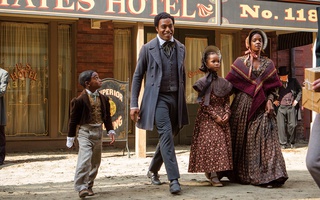
The films crafted by the fifteen students at the Harvard Summer School program in Berlin focused on individuals like Martin, shown here exploring the Schwules Museum.
Black and white shots of storefronts and sidewalks played across the screen of the Carpenter Center’s viewing rooms as an older British man’s voice rang out, judgmentally branding Berlin as a new Sodom. “I would get to Berlin just as soon as I ever could and...I would stay there a long, long time,” said the younger protagonist. The interchange, from pioneering gay author Christopher Isherwood’s 1962 novel “Down There On a Visit,” set the stage for the short film, one of eight screening last Thursday. The production was, according to co-director Mercedes N. Flowers ’16, an examination of the state of affairs in the Nollendorfplatz, a vibrant center of gay life in Berlin that was one of the earliest thriving LGBT centers in the modern Western world. Flowers and her fellow director J. Timberlake Shepherd, a student at New College of Florida, were part of a Harvard Summer School program that gave 15 students a hands-on intensive class on basic documentary theory and Berlin’s film history, then let them out into the city to find subjects worthy of their final project, a 10-minute documentary.
Eric Rentschler, the Arthur Kingsley Porter professor of Germanic languages and literatures at Harvard, partnered with Berlin-centered documentarian Stefan Majakowski to lead the course. The class centered on a film appreciation seminar, which featured films made in Berlin and made about Berlin. “Over the course of the semester the students watched about 25 feature films about Berlin spanning from 1895 to the present and came out with a sense of how Berlin had appeared and had been employed…they could see how the city was mapped,” Rentschler says. Armed with their cultural knowledge, the students next received instruction from Majakowski about how to effectively film short subjects. According to Flowers, much of Majakowski’s teaching centered around avoiding cliché tropes of popular documentaries. “He was very outspoken about certain styles of documentary that he absolutely hated...like ‘ego docs,’ where one would say, ‘look at me, I’m in Nollendorfplatz! Look at me! Look at me!’,” Flowers says. She also commented on his disdain for documentaries minimally concerned with artistic flair, in which the viewer was simply informed about the location.
Rentschler, who lives in Berlin part-time and has spent much of his career studying the city (Flowers dubbed him the “King of Berlin”), helped students solidify their conceptual sketches for their planned films, using his web of knowledge and connections to direct the students to places where they were likely to find contacts. Rentschler oriented Flowers and Shepherd to the Nollendorplatz and got them in touch with the curator of the Schwules Museum, the world’s first gay museum. Afraid that they would end up making a boring film that amounted to little more than a walk-through of the collection, the duo searched the streets and haunts of the neighborhood for a more human perspective on Berlin’s gay culture.
“Initially there was an element of despair,” Flowers says. “We had to find a subject or individual who could adequately convey the culture and history of the city in a 10 minute film.” In search of a muse for their project, Flowers and Shepherd tracked down Martin, a DJ in the neighborhood who volunteered to administer testing and lead youth groups at a local community center. He gave an impressive tour of the area, coupling his commentary on the fun clubs and clothing stores with a deeper discourse on the often contradictory pressures of gay men to be muscled yet feminine and be sexually prolific but get good marks at university.
Shepherd and Flowers were not alone in their choice to profile an individual or small group as a means of showcasing larger cultural realities. Renee E. Zhan '16 and Max R. McGillivray '16 examined the shift in German values over the last 30 years by interviewing a husband and wife artistic team who gained fame in the 1980s for creating brash artistic installations on the Berlin Wall. Sam S. Richman '15 and Emmet W. Stackelberg '14 created a polemic on urbanization—they traced the reactions of a small garden community in Neukölln to the news that their houses would be demolished to make way for a large highway. Other groups interviewed eccentric expatriates and seedy clubbers, using split screen, music, subtitles, montage, and historical footage to enhance their examinations.
When asked about the general themes of the films, Rentschler commented on the tendency for character study. “Many of the films focus on certain exemplary personalities…. The students developed relationships with eccentric, interesting, and often deeply enigmatic people in [Berlin] and tried to give a sense of how these people live, think, and feel in the city,” he says. Rentschler seemed especially impressed by the progression from relative awkwardness and distance to candor and honesty between the filmmakers and their subjects, and he was pleased with the final results. “There’s not one weak film in the bunch. They are all strong in their own ways.”
Read more in Arts
The K-Indie SceneRecommended Articles
-
Large Gift Boosts Film Archive’s CollectionHarvard’s once small collection of film stills—movie frames studied by film historians—is slowly ballooning into one of the country’s ten
-
 A.R.T.'s 'Gatz' Takes Classic Tale to Stage in Novel Adaptation
A.R.T.'s 'Gatz' Takes Classic Tale to Stage in Novel Adaptation -
Soft Robots Jump Higher, React FasterNew advances in soft-robotics allow these more flexible robots to react faster than ever before.
-
 Script Doctors
Script Doctors -
VES Would House Doctoral Program With Proposed MergerThe undergraduate-only Department of Visual and Environmental Studies could formally house its own graduate program for the first time in 50 years, should the Faculty of Arts and Sciences approve a proposed merger between VES and the Standing Committee on the Ph.D. in Film and Visual Studies.













